Hawaii is home to several species of dolphins. These intelligent and social creatures are often spotted frolicking in the warm Hawaiian waters, offering both locals and tourists a truly remarkable experience. In this section, we’ll delve into the unique types of dolphins that call Hawaii their home, each with its distinctive characteristics and behaviors.
1. Spinner Dolphin (Stenella longirostris)
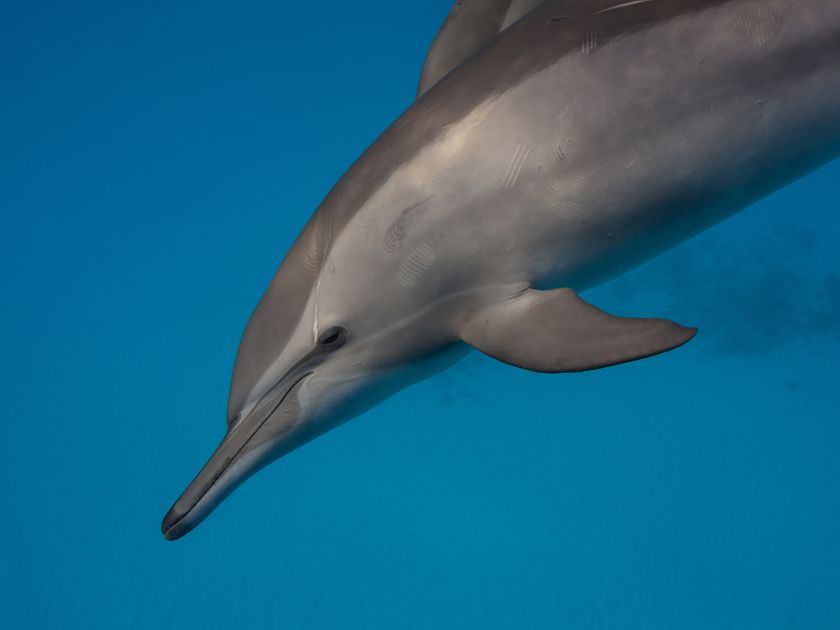
Description and characteristics
Dolphins are renowned for their sleek, streamlined bodies designed for swift movement through the water. These creatures’ length is typically 7 feet (2.1 m), and weigh up to 170 pounds (77 kg). They have a dorsal fin, along with a pair of pectoral fins, which enable them to navigate and maintain balance. The skin of a dolphin is smooth and rubbery to the touch, with a layer of blubber beneath for insulation in colder waters. Their color varies between species, ranging from light gray to dark, sometimes with distinctive patterns. Dolphins possess a set of conical teeth, suited for their diet of fish and squid. A characteristic of dolphins is their ‘melon’, a fat-filled area in their forehead that aids in echolocation. Their eyes are on the sides of their heads, enabling a wide field of vision. Dolphins also have a blowhole on top of their heads for breathing – a marvelous adaptation for a marine lifestyle.
Habitats and behavior
The Spinner Dolphin is known for primarily inhabiting the open ocean, but in regions like Hawaii, they are also found in nearshore waters. They are highly social creatures and are often spotted in large groups known as pods, which can consist of hundreds or even thousands of individuals. These dolphins exhibit diurnal behavior – they feed on offshore squid and small fish at night, while the daytime is reserved for resting in the calm waters of bays and lagoons. Their playful and acrobatic behavior, which includes leaping and spinning in the air, is not just entertaining to watch but also serves the practical purpose of shaking off parasites.
Role in Hawaiian Culture
Dolphins hold a special place in Hawaiian culture and are deeply interwoven with its traditions and mythology. Known as “Nai’a” in the Hawaiian language, they symbolize both joy and harmony. Ancient Hawaiians revered dolphins, viewing them as divine messengers of the gods. They believed that dolphins were ‘aumakua, or family guardians, who protect people from danger. Dolphins also frequently feature in Hawaiian folk tales, often portrayed as helpful and benevolent creatures that guide lost sailors back to shore. Today, these cultural beliefs continue to resonate with the people of Hawaii, accentuating their efforts to conserve and protect these magnificent marine animals.
Status
The International Union for Conservation of Nature (IUCN) currently classifies the Spinner Dolphin as a species of least concern, owing to their widespread distribution and large global population. Despite being protected under the Marine Mammal Protection Act, their numbers are believed to have been impacted by frequent human interactions, leading to disturbance in their resting periods. Conservation efforts are underway to protect these magnificent creatures and create a sustainable environment for them in Hawaii’s waters.
2. Bottlenose Dolphin (Tursiops truncatus)
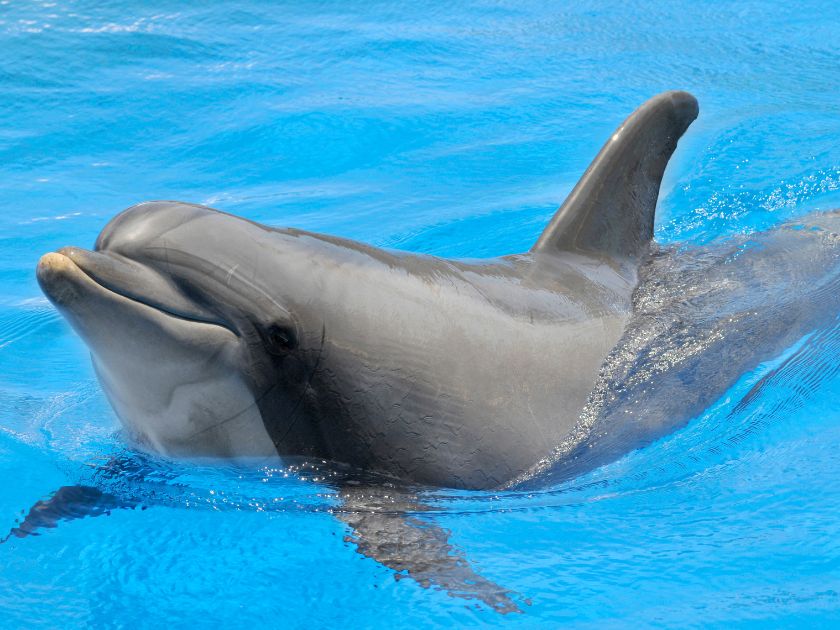
Description and characteristics
Adult bottlenose dolphins are large, robust creatures, typically measuring 2 to 3.9 m (6.6 to 12.8 ft.) in length and weighing up to 1,300 pounds. They are notably grey, ranging from dark grey at the top near the dorsal fin to lighter grey on their belly. Their sleek, streamlined bodies enable them to cruise the ocean at high speeds, and their hook-shaped dorsal fins aid in maneuverability and stability while swimming.
Habitats and behavior
Bottlenose Dolphins, renowned for their intelligence and sociability, reside in diverse marine habitats such as open seas, coastal areas, and even large rivers. They are particularly drawn to areas with warm temperatures like the tropical Hawaiian waters. These dolphins travel in groups called pods, consisting of 10 to 30 members on average, although super pods of over 1000 dolphins have been observed. They demonstrate complex behaviors, including cooperation during hunting, mutual grooming, and playful interactions. Their diet primarily consists of small fish and squid. Notably, Bottlenose Dolphins are known to use unique hunting techniques, such as ‘strand feeding’, where they drive fish onto shore and briefly beach themselves to consume their prey.
Status
Classified as “Least Concern” on the IUCN Red List, their global population is relatively stable. However, in specific areas, including Hawaii, they face challenges such as habitat degradation, pollution, and human interaction, which can impact local populations. Therefore, while not endangered, their status necessitates continuous monitoring and conservation efforts to ensure their ongoing survival and well-being in their native habitats.
3. Spotted Dolphin (Stenella frontalis)
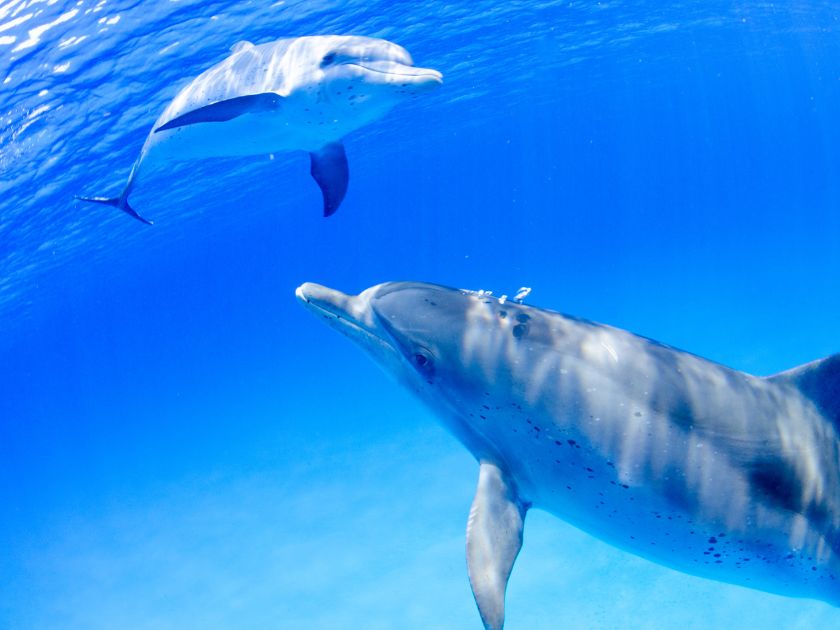
Description and characteristics
Spotted dolphins are easily distinguishable by their slim bodies, long beaks, and distinctive tri-color pattern consisting of a dark back, light flank, and white belly. Mature Spotted Dolphins can reach a length of 5 to 7.5 feet and weigh approximately 220 to 315 pounds. They have a conical head with a pronounced melon, and their characteristic dorsal fin exhibits a curved, sickle-like shape. Their color pattern becomes more pronounced with age, with older dolphins exhibiting a more mottled appearance.
Habitats and behavior
Spotted Dolphins are often seen in the warm, tropical waters off the coast of Hawaii. They typically inhabit offshore waters, where they form large pods – sometimes of a thousand or more individuals. Their behavior is energetic and social; they’re known to ride the bow wave created by boats, leaping and spinning in the air. These dolphins are diurnal, displaying peak activity during daylight hours. Their diet mainly consists of small fish and squid, which they hunt using echolocation.
Status
This type of dolphin is currently listed as “Least Concern” on the International Union for Conservation of Nature (IUCN) Red List. This status signifies that the species, while not presently facing immediate threats of extinction, requires ongoing conservation efforts to ensure its survival. Factors such as ocean pollution, accidental capture in fishing nets, and climate-induced changes to their natural habitats pose significant challenges to the Spotted Dolphin population. In Hawaii, local authorities and conservation organizations are actively working to protect these enchanting creatures and their marine environment.
4. Risso’s Dolphins (Grampus griseus)
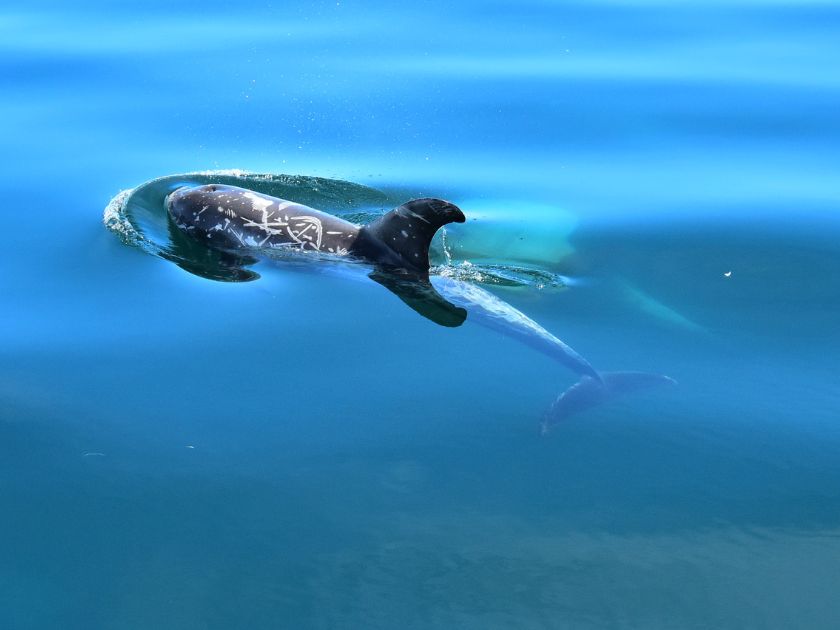
Description and characteristics
These large dolphins can reach lengths of up to 13 feet and weigh approximately 1,100 pounds, making them one of the larger dolphin species in the region. They are characterized by a robust body, a tall, falcate dorsal fin, and a bulbous forehead, or “melon”, that becomes more pronounced with age. Risso’s Dolphins have a distinct color pattern, starting with a light gray when they’re young and slowly acquiring a dark gray to almost white coloration, with scars and scratches from social interactions and feeding, as they age. The unique features of Risso’s Dolphins make them an exciting sight on any Hawaiian dolphin-watching excursion.
Habitats and behavior
Risso’s Dolphins primarily inhabit the deep offshore waters, often observed around seamounts and continental shelves. They tend to be less acrobatic than other species; instead, they are known for their unique “rooster tail” splash when traveling at high speeds. These creatures exhibit a robust social structure, often seen traveling in groups, known as pods, that can range from a handful to hundreds of dolphins. Their diet primarily consists of squid, making their feeding habits nocturnal as they dive deep into the ocean when their prey is most active. Intriguingly, older Risso’s Dolphins can be identified by the numerous white scars on their bodies, which are the marks from battles with squid or interactions with other Risso’s Dolphins.
Status
Risso’s Dolphins, or Grampus griseus, are currently classified as “Least Concern” on the International Union for Conservation of Nature’s (IUCN) Red List. While Risso’s Dolphins are not currently classified as endangered, uncertainties around their exact population in Hawaiian waters call for continued research and monitoring to ensure their survival and well-being. They are widely spread across the Hawaiian archipelago, often seen in deep offshore waters. Human activities such as fishing, marine pollution, and climate change pose potential threats to their conservation status.
5. Rough-Toothed(Steno bredanensis)
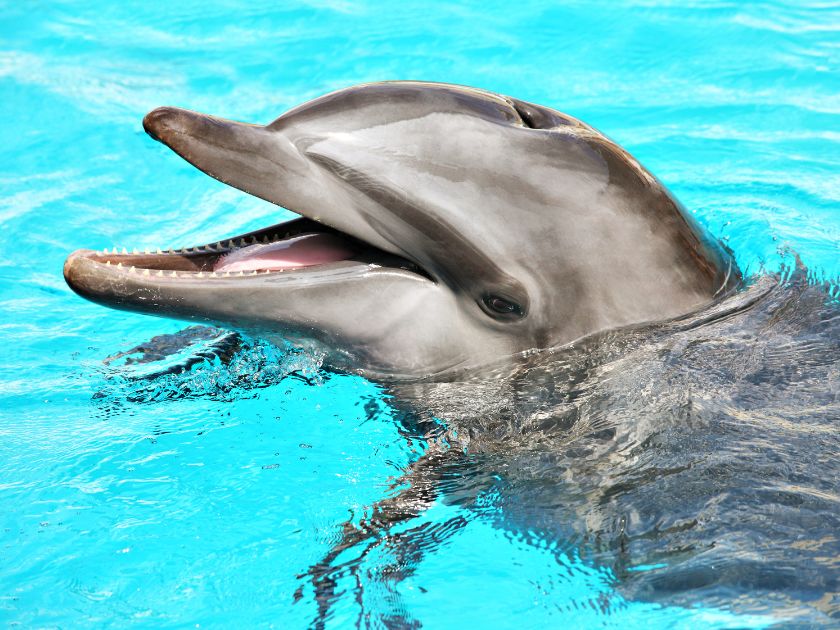
Description and characteristics
The Rough-Toothed Dolphin is a fascinating species that can be spotted in the warm coastal waters of Hawaii. These marine creatures can reach a length of approximately 2.1 to 2.9 meters (6.9-9.5 feet), and weigh between 90 and 155 kilograms (198-342lbs), making them relatively smaller than their dolphin counterparts. One of the distinctive characteristics of Rough-Toothed Dolphins is their conical head and slender body, which is mainly light to slate gray, with pinkish-white underparts. Their long, thin beak filled with uniformly sized, rough-edged teeth, hence the name, sets them apart from other dolphin species.
Habitats and behavior
The Rough-Toothed Dolphin is typically found in deep offshore waters, preferring warm, tropical, or subtropical oceans over cooler environments. Unlike many other dolphin species, they appear to have a preference for the open sea, often staying miles away from the coast. As for their behavior, the Rough-Toothed Dolphin is known for its social nature. They are usually found in tightly-knit groups, sometimes consisting of 10 to 20 individuals, although larger pods of up to several hundred have been reported. These social animals often engage in playful behavior, breaching the water, and riding swells and wake created by boats. They also exhibit a unique feeding behavior, hunting for fish and squid both at the surface and at significant depths, using their conical teeth and long, slender snouts.
Status
The rough-toothed dolphin is currently listed as “Least Concern” on the IUCN Red List of Threatened Species. While they are not considered endangered or threatened, their exact population size in the Hawaiian waters remains largely unknown, primarily due to their offshore habits. Efforts are ongoing to learn more about these intriguing marine mammals and to ensure their continued presence in Hawaii’s waters.
6. Short-beaked (Delphinus delphis)
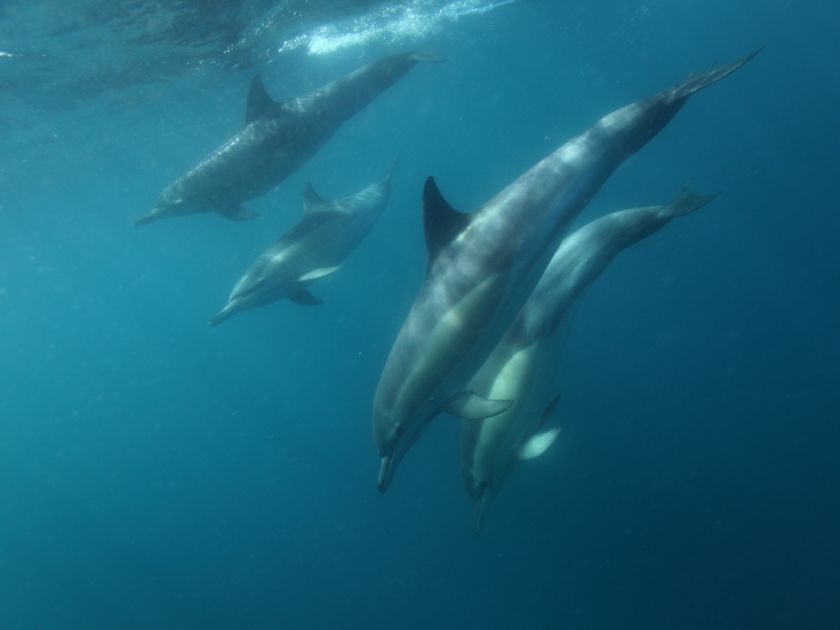
Description and characteristics
The Short-beaked Common Dolphin is a vivacious creature that lights up Hawaii’s oceanic panorama. This species typically weighs between 220 – 330 lbs and measures approximately 2 to 2.7 meters in length (6.6 to 8.9 feet), signifying a robust oceanic presence. Its anatomy is characterized by a slender body, a distinct “hourglass” pattern on the sides, and a dorsal fin in the mid-back region. The color scheme is a delightful blend, with a dark back, a white belly, and light grey patterns on the sides, accentuating its charm and making it easily recognizable. These dolphins are indeed one of the fascinating inhabitants of the Hawaiian waters.
Habitats and behavior
This dolphin is a well-traveled marine mammal, found in both warm tropical and cooler temperate waters worldwide. However, they seem to prefer the slightly warmer offshore waters, where food sources are abundant. Agile and lively, these dolphins are known for their playful behavior. They are often seen leaping, riding swells and waves created by boats – a phenomenon known as “bow-riding”. Social creatures typically live in large pods ranging from hundreds to thousands of individuals, although smaller groups are also common. When it comes to their diet, Short-Beaked Common Dolphins have a varied menu. They feed on a selection of fish like herring and sardines, and cephalopods such as squid, employing cooperative hunting strategies for efficient feeding.
Status
Despite the name ‘common’, they are not as common as Spinner Dolphins in the region; however, they are not currently considered endangered or threatened. Research and conservation efforts are ongoing to ensure the continued presence of these energetic creatures in Hawaii’s marine ecosystems. The Short-Beaked Common Dolphin qualifies as “Least Concern” in the IUCN Red List of Threatened Species.
7. Striped Dolphin (Stenella coeruleoalba)
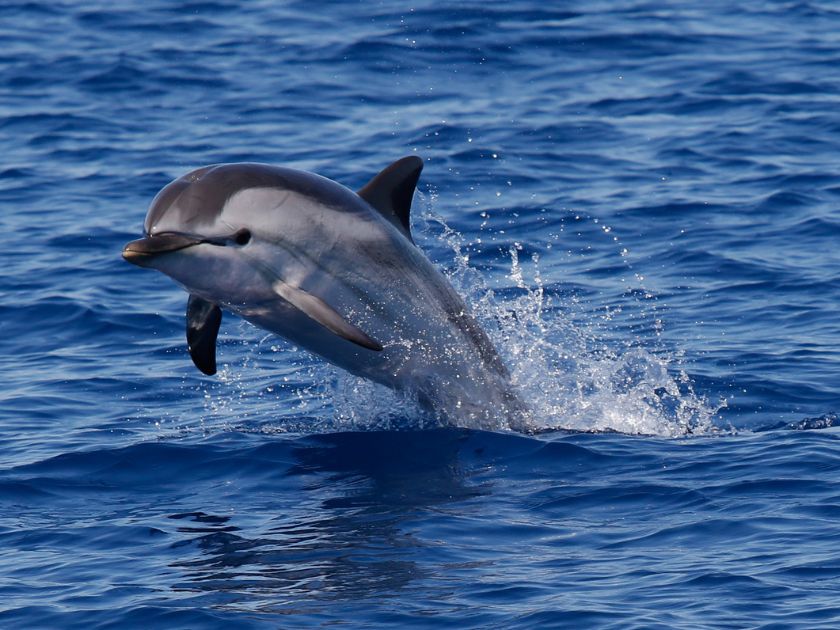
Description and characteristics
The Striped Dolphin is one of the most widespread dolphins populating the warm tropical oceans. An adult Striped Dolphin typically weighs 350 pounds and measures approximately 7.9-8.5 feet in length. The anatomy of a Striped Dolphin is sleek and streamlined, designed for efficient movement through the water. They are easily identifiable by their characteristic color pattern. The underside is blue, white, or pinkish, while the back and sides are a darker blue. A distinguishing feature is the pattern of blue and white stripes running from the eye to the flipper, giving this species its common name. Their elongated, beak-like snouts contain rows of sharp, conical teeth, aiding in their consumption of a diet mainly composed of small fish and squid.
Habitats and behavior
This type of dolphin exhibits a global distribution, with notable populations present in the warm, tropical waters surrounding Hawaii. The species typically favors offshore habitats, predominantly residing in regions with a water depth exceeding 600 meters. While the Striped Dolphin appreciates the open ocean, these creatures can occasionally be spotted in nearshore areas adjacent to deep water canyons or oceanic islands, such as the Hawaiian archipelago. The striped Dolphin is known for its energetic and acrobatic displays, often breaching and leaping out of the water. These dolphins are fast swimmers and are frequently seen riding the bow wave created by boats. They’re highly social creatures, forming large pods, which can consist of hundreds or even thousands of individuals. These groups may be segregated by age and sex. They’re also known to associate with other species of dolphins, suggesting a level of interspecies cooperation. They feed on a diet primarily consisting of small fish and squid, often diving to significant depths to catch their prey.
Status
Their status in Hawaiian waters is considered stable, although precise population numbers are not currently known. These dolphins are mostly offshore creatures, only occasionally coming closer to the coastlines. As with any marine life, they face potential threats from pollution, fishing, and human disturbance. Therefore, continuous monitoring and conservation efforts are crucial to ensure their continued survival in Hawaii’s waters. The Striped Dolphin is listed as “Least Concern” on the International Union for Conservation of Nature (IUCN) Red List.
8. Pilot Whale (Globicephala)
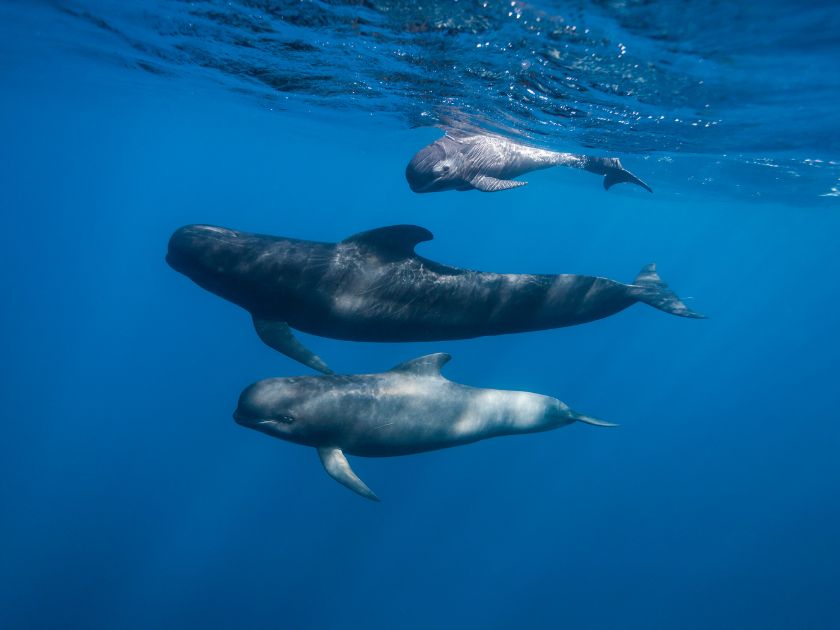
Description and characteristics
The Pilot Whale is one of the larger dolphin species commonly sighted in the waters around Hawaii. These sizable marine creatures can range from 12 to 24 feet in length, and weigh between 1,000 and 3,000 kilograms. Their bodies are robust and elongated, with a bulbous forehead and a distinctive, sickle-shaped dorsal fin. The coloration of Pilot Whales varies from dark grey to black, with a lighter patch on the belly and a gray or white anchor-shaped patch on the chest. They have a unique set of teeth – between eight and twelve on each side of both jaws – which is designed for their diet mainly consisting of squid and small fish.
Habitats and behavior
These marine mammals prefer deep waters and are known for their long-distance migrations, covering vast oceanic expanses. Pilot Whales are highly social and are typically found in pods of 20 to 90 individuals, although super pods can comprise hundreds of members. They exhibit complex social structures reminiscent of elephants, with strong matriarchal leadership. These intriguing creatures spend their days diving deep into the ocean’s depths, hunting for squid and fish. On the surface, they are known for their playful behavior, often leaping out of the water, much to the delight of onlookers. Despite their majestic presence and apparent abundance, these marine mammals face threats from pollution, overfishing, and accidental catches. Their survival is a testament to the resilience of nature and a reminder of our shared responsibility to protect it.
Status
Currently, the Short-finned Pilot Whale is listed as “Data Deficient” on the IUCN Red List, meaning more research is needed to determine its conservation status. Efforts are being made to understand their population dynamics better and implement protective measures accordingly.
9. False Killer Whale (Pseudorca crassidens)
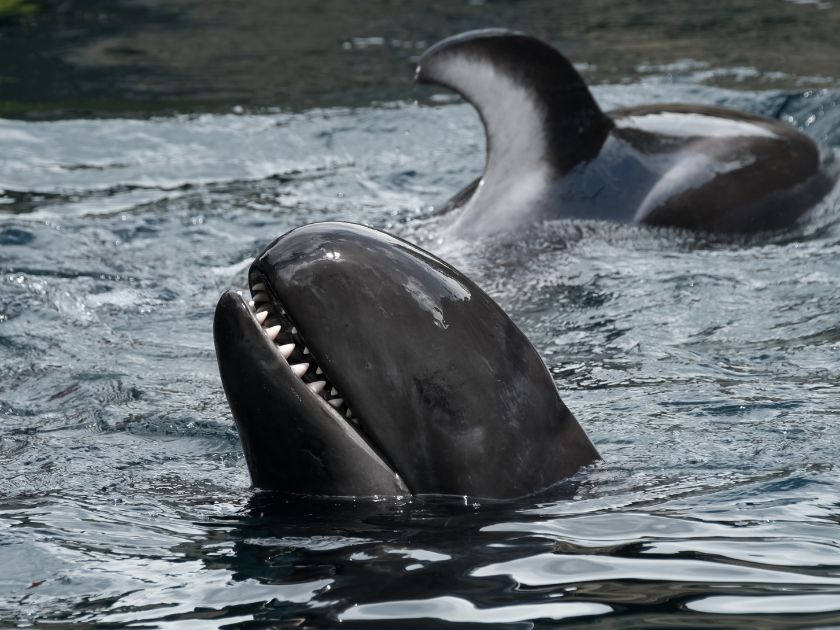
Description and characteristics
The False Killer Whale is one of the largest members of the dolphin family. These marine mammals are typically black or dark gray, distinguished by their elongated bodies and slender, tapering heads with no discernible beaks. Adult False Killer Whales can reach lengths of up to 20 feet and weigh up to 3,000 pounds, with males generally being larger than females. They have a distinct dorsal fin located midway on their bodies, along with a pair of pectoral flippers that are notably large and curved back towards the body, granting them superior mobility in water. Highly social creatures, False Killer Whales are known for their playful nature, often seen leaping out of the water and riding swells and wakes. Despite their intimidating name, these dolphins are far from false when it comes to their intriguingly complex and dynamic personalities.
Habitats and behavior
False Killer Whales are deep-water dolphins found in tropical to temperate oceanic waters, particularly in Hawaiian waters. They live in well-structured pods, with pods ranging from 10 to 20 individuals. These sociable dolphins are fast swimmers and active predators, with a varied diet including large fish and squid. They chase prey at high speeds, demonstrating coordinated hunting strategies. Their vocal behavior, consisting of clicks, whistles, and burst pulses, is crucial for their echolocation ability. They are known for their curiosity and occasional playfulness towards humans. However, due to their elusive nature and preference for deeper waters, encounters with these dolphins are rare and special.
Status
In Hawaii, the False Killer Whale holds a unique and distinctive position. This species, in particular, is separated into three populations: the offshore population, the Northwestern Hawaiian Islands population, and the Main Hawaiian Islands Insular population. The most concerning of these is the Main Hawaiian Islands Insular population, which is listed as endangered under the Endangered Species Act of 1973. This population has suffered a significant decline over the past few decades, with estimates suggesting that fewer than 150 individuals remain.
10. Pantropical Spotted (Stenella attenuata)
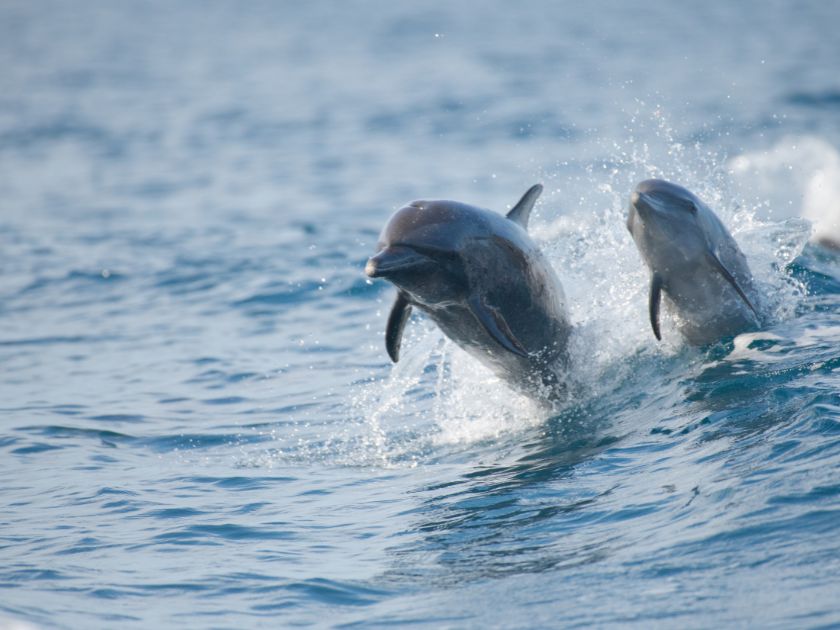
Description and characteristics
This is one of the most fascinating dolphin species that grace the Hawaiian waters. Adults typically weigh between 250 to 300 pounds and measure an impressive 6 to 8 feet in length. Their name reflects their unique physical appearance, which is characterized by spots that cover their bodies. Juveniles start with a uniformly gray color, but as they mature, lighter spots begin to appear on their darker back (dorsal side), while darker spots appear on their lighter belly (ventral side). This distinctive spotted pattern renders each dolphin unique, mirroring a natural aquatic tapestry of sorts. In terms of anatomy, like other dolphins, they possess a streamlined body and a dorsal fin for efficient swimming. Their beak is long and thin, allowing swift and precise movements while hunting for food or navigating the ocean depths.
Habitats and behavior
The Pantropical Spotted Dolphin, commonly found in the warm tropical waters of Hawaii, is renowned for its distinctive spotted pattern. This agile creature thrives and primarily resides in offshore waters, often found in depths greater than 1,000 meters. However, in the Hawaiian region, they are frequently sighted in shallower waters as well.
Behaviorally, these dolphins are quite social and are often observed in large pods of hundreds to thousands of individuals. Their social structure is complex and based on age, sex, and reproductive status. Known for their playful demeanor, they often display acrobatic behaviors such as jumping, spinning, and flipping out of the water. A unique trait of the Pantropical Spotted Dolphin is that it is often associated with other species of dolphins, making it a fascinating subject for studies in interspecies social behavior.
Status
These intelligent creatures thrive in the region due to the abundant food supply and mild climate and are currently listed as “Least Concern” on the International Union for Conservation of Nature (IUCN) Red List. Despite this abundance, they are not without threats. Commercial fishing operations pose a significant risk as the dolphins often get caught in fishing nets, leading to injury or death. Current conservation efforts focus on implementing safer fishing practices and bolstering public awareness to protect these captivating creatures.
Ethical Considerations
While it’s certainly a thrill to witness dolphins in their natural environment, we must respect these intelligent creatures and their habitat. Ethical dolphin watching involves maintaining a safe distance to avoid disturbing their natural behaviors or causing them undue stress. Interacting directly with dolphins, including swimming with them, can disrupt their rest, nursing, and feeding routines and lead to unhealthy changes in their behavior. It’s also important to choose tour operators who follow established guidelines for responsible wildlife viewing, ensuring that our desire to appreciate these incredible animals does not harm them in the process.
Conservation Efforts
Despite the joy they bring to wildlife enthusiasts, dolphins in Hawaii face several threats, including pollution, habitat loss, and accidental capture in fishing nets, which necessitate concerted conservation efforts. Local organizations such as the Hawaiian Marine Life Conservation Society work tirelessly to protect these creatures and their habitats, conducting research, raising awareness, and lobbying for stronger environmental legislation. Internationally, bodies like the World Wildlife Fund (WWF) also contribute to the cause, advocating globally for more responsible fishing practices and marine conservation. These collaborative efforts between local and international organizations are instrumental in ensuring the survival of Hawaii’s dolphin populations for future generations.
Hawaii’s Dolphins are National Treasures that Require Protection
It is our collective responsibility to ensure their survival for future generations. By supporting conservation efforts and taking part in ethical dolphin watching, we can contribute to the welfare of these majestic creatures. Choose tour operators that follow respectful wildlife viewing practices, maintain a safe distance, and avoid disrupting their natural behaviors. Let’s come together to preserve the magic and beauty of Hawaii’s dolphins for years to come. Every dolphin deserves a safe and healthy home; let’s do our part to keep it that way.





Where can I paste a picture of a dolphin that I want you to see that was from the Hawaiian islands….